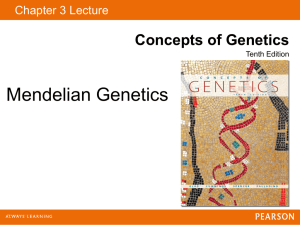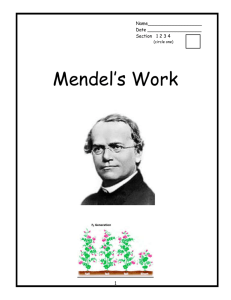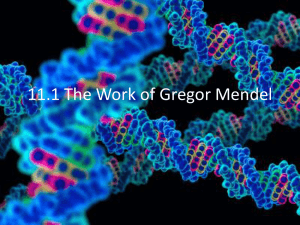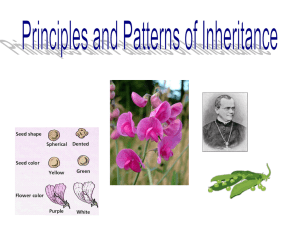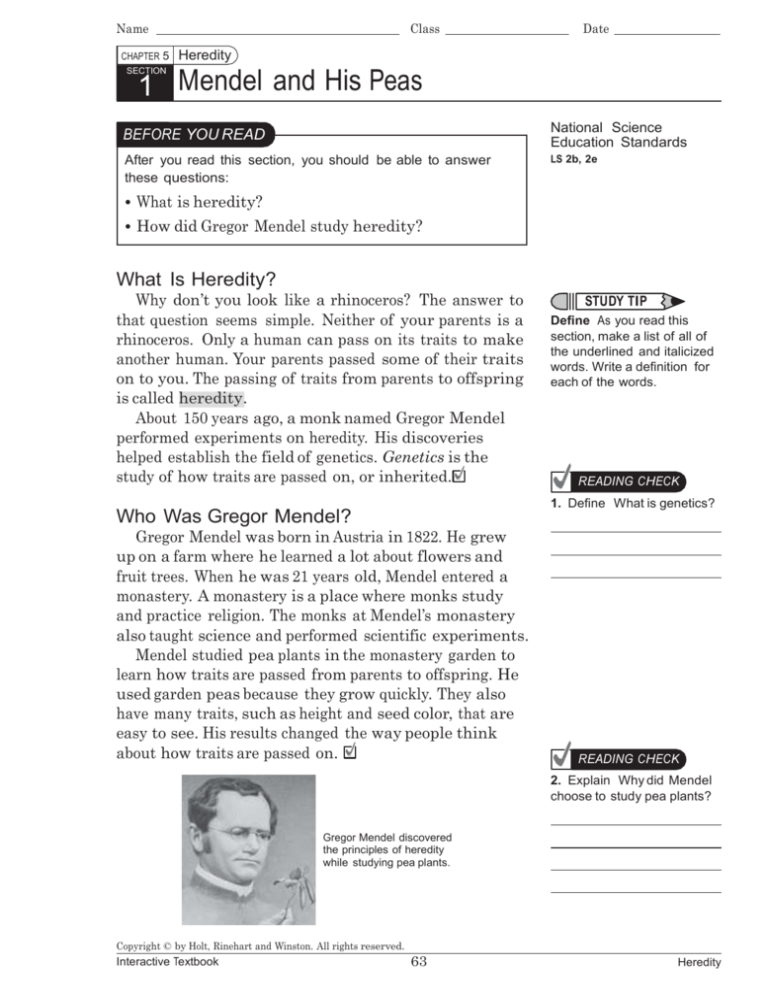
Name
CHAPTER 5
Class
Date
Heredity
SECTION
1 Mendel and His Peas
National Science
Education Standards
BEFORE YOU READ
After you read this section, you should be able to answer
these questions:
LS 2b, 2e
• What is heredity?
• How did Gregor Mendel study heredity?
What Is Heredity?
Why don’t you look like a rhinoceros? The answer to
that question seems simple. Neither of your parents is a
rhinoceros. Only a human can pass on its traits to make
another human. Your parents passed some of their traits
on to you. The passing of traits from parents to offspring
is called heredity.
About 150 years ago, a monk named Gregor Mendel
performed experiments on heredity. His discoveries
helped establish the field of genetics. Genetics is the
study of how traits are passed on, or inherited.
STUDY TIP
Define As you read this
section, make a list of all of
the underlined and italicized
words. Write a definition for
each of the words.
READING CHECK
1. Define What is genetics?
Who Was Gregor Mendel?
Gregor Mendel was born in Austria in 1822. He grew
up on a farm where he learned a lot about flowers and
fruit trees. When he was 21 years old, Mendel entered a
monastery. A monastery is a place where monks study
and practice religion. The monks at Mendel’s monastery
also taught science and performed scientific experiments.
Mendel studied pea plants in the monastery garden to
learn how traits are passed from parents to offspring. He
used garden peas because they grow quickly. They also
have many traits, such as height and seed color, that are
easy to see. His results changed the way people think
about how traits are passed on.
READING CHECK
2. Explain Why did Mendel
choose to study pea plants?
Gregor Mendel discovered
the principles of heredity
while studying pea plants.
Copyright © by Holt, Rinehart and Winston. All rights reserved.
Interactive Textbook
63
Heredity
Name
SECTION 1
Class
Date
Mendel and His Peas continued
REPRODUCTION IN PEAS
Critical Thinking
3. Compare What is the
difference between
cross-pollination and
self-pollination?
Like many flowering plants, pea plants have both male
and female reproductive parts. Many flowering plants can
reproduce by cross-pollination. In most plants, sperm are
carried in structures called pollen. In cross-pollination,
sperm in the pollen of one plant fertilize eggs in the flower
of another plant. Pollen can be carried by organisms, such
as insects. It may also be carried by the wind from one
flower to another.
Some flowering plants must use cross-pollination.
They need another plant to reproduce. However, some
plants, including pea plants, can also reproduce by selfpollination. In self-pollination, sperm from one plant fertilize the eggs of the same plant.
Mendel used self-pollination in pea plants to grow
true-breeding plants for his experiments. When a
true-breeding plant self-pollinates, its offspring all have
the same traits as the parent. For example, a true-breeding
plant with purple flowers always has offspring with purple
flowers.
Self-pollination
Cross-pollination
by animals
Stigma
Cross-pollination
by wind
Pollen
Anther
TAKE A LOOK
4. Identify What are two
ways pollen can travel from
one plant to another during
cross-pollination?
Ovary
Petal
Ovule
During pollination, pollen from the anther (male) is carried to the stigma
(female). Fertilization happens when a sperm from the pollen moves through the
stigma and enters an egg in an ovule.
Copyright © by Holt, Rinehart and Winston. All rights reserved.
Interactive Textbook
64
Heredity
Name
SECTION 1
Class
Date
Mendel and His Peas continued
CHARACTERISTICS
A characteristic is a feature that has different forms.
For example, hair color is a characteristic of humans.
The different forms or colors, such as brown or red hair,
are traits.
Mendel studied one characteristic of peas at a time. He
used plants that had different traits for each characteristic he studied. One characteristic he studied was flower
color. He chose plants that had purple flowers and plants
that had white flowers. He also studied other characteristics, such as seed shape, pod color, and plant height.
READING CHECK
5. Explain How are
characteristics and
traits related?
CROSSING PEA PLANTS
Mendel was careful to use true-breeding plants in his
experiments. By choosing these plants, he would know
what to expect if his plants self-pollinated. He decided to
find out what would happen if he bred, or crossed, two
plants that had different traits.
This plant produces
wrinkled seeds.
This plant produces
round seeds.
Anther
Say It
Describe How would you
describe yourself? Make a list
of your physical traits, such
as height, hair color, and eye
color. List other traits you
have that you weren’t born
with. Share this list with your
classmates. Which of these
traits did you inherit?
TAKE A LOOK
6. Describe How did
Mendel make sure that the
plant with round seeds did
not self-pollinate?
Stigma
Anthers are
removed.
Mendel removed the anthers from a plant that made round seeds. Then,
he used pollen from a plant that made wrinkled seeds to fertilize the
plant that made round seeds.
Copyright © by Holt, Rinehart and Winston. All rights reserved.
Interactive Textbook
65
Heredity
Name
SECTION 1
Class
Date
Mendel and His Peas continued
What Happened in Mendel’s First Experiments?
READING CHECK
7. Identify What kind of
trait appeared in the first
generation?
Mendel studied seven different characteristics in his
first experiments with peas. He crossed plants that were
true-breeding for different traits. For example, he crossed
plants that had purple flowers with plants that had white
flowers. The offspring from such a cross are called
first-generation plants. All of the first-generation plants
in this cross had purple flowers. What happened to the
trait for white flowers?
Mendel got similar results for each cross. One trait
was always present in the first generation and the other
trait seemed to disappear. Mendel called the trait that
appeared the dominant trait. He called the other trait
the recessive trait. To recede means “to go away or
back off.” To find out what happened to the recessive
trait, Mendel did another set of experiments.
What Happened in Mendel’s Second
Experiment?
Mendel let the first-generation plants self-pollinate.
Some of the offspring were white-flowered, even though
the parent was purple-flowered. The recessive trait for
white flowers had reappeared in the second generation.
Mendel did the same experiment on plants with seven
different characteristics. Each time, some of the secondgeneration plants had the recessive trait.
Parent Generation
Pollen
transfer
First Generation
All flowers are purple.
A mature plant
is allowed to
self-pollinate.
TAKE A LOOK
8. Identify What type of
traits appeared in the second
generation?
Second Generation
For every three plants that have
purple flowers, there is one
plant that has white flowers.
Copyright © by Holt, Rinehart and Winston. All rights reserved.
Interactive Textbook
66
Heredity
Name
SECTION 1
Class
Date
Mendel and His Peas continued
RATIOS IN MENDEL’S EXPERIMENTS
Mendel counted the number of plants that had each
trait in the second generation. He hoped that this might
help him explain his results.
As you can see from the table below, the recessive
trait did not show up as often as the dominant trait.
Mendel decided to figure out the ratio of dominant traits
to recessive traits. A ratio is a relationship between two
numbers. It is often written as a fraction. For example,
the second generation produced 705 plants with purple
flowers and 224 plants with white flowers. Mendel used
this formula to calculate the ratios:
705
3.15 or 3.15:1
224 = 1
Dominant
trait
Recessive
trait
Flower color
705
purple
224
white
Seed color
6,002
yellow
Seed shape
5,474
round
Pod color
428
green
Pod shape
882
smooth
299
bumpy
Flower
position
651
along
stem
207
at tip
Plant
height
787
tall
277
short
Characteristic
Ratio
3.15:1
Math Focus
9. Find Ratios Calculate the
ratios of the other pea plant
characteristics in the table.
2,001
green
1,850
wrinkled
152
yellow
Math Focus
10. Round Round off all
numbers in the ratios to
whole numbers. What ratio
do you get?
What Did Mendel Conclude?
Mendel knew that his results could be explained only if
each plant had two sets of instructions for each characteristic. He concluded that each parent gives one set of
instructions to the offspring. The dominant set of instrucCopyright © by Holt, Rinehart and Winston. All rights reserved.
Interactive Textbook
67
Heredity
Name
Class
Date
tions determines the offspring’s traits.
Copyright © by Holt, Rinehart and Winston. All rights reserved.
Interactive Textbook
68
Heredity
Name
Class
Section 1 Review
Date
NSES
LS 2b, 2e
SECTION VOCABULARY
dominant trait the trait observed in the first
generation when parents that have different
traits are bred
heredity the passing of genetic traits from
parent to offspring
recessive trait a trait that is apparent only when
two recessive alleles for the same characteristic
are inherited
1. Define What is a true-breeding plant?
2. Apply Concepts Cats may have straight or curly ears. A curly-eared cat mated with
a straight-eared cat. All the kittens had curly ears. Are curly ears a dominant or
recessive trait? Explain your answer.
3. Summarize Complete the cause and effect map to summarize Mendel’s
experiments on flower color in pea plants.
True-breeding plants
with purple flowers
were crossed
to produce
When self-pollinated, they produced
Copyright © by Holt, Rinehart and Winston. All rights reserved.
Interactive Textbook
69
Heredity
Name
Class
Date
Copyright © by Holt, Rinehart and Winston. All rights reserved.
Interactive Textbook
70
Heredity

![Biology Chapter 3 Study Guide Heredity [12/10/2015]](http://s3.studylib.net/store/data/006638861_1-0d9e410b8030ad1b7ef4ddd4e479e8f1-300x300.png)


